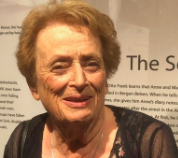
Meet Inge Woolf: Director of the Holocaust Centre of New Zealand and Anne Frank NZ advisory board member
Q: You’re on the advisory board for the Anne Frank exhibition. Can you tell us how you got involved and what attracted you to the exhibition?
A: As Director of the Holocaust Centre of New Zealand, I've been involved in the project ever since a representative from Anne Frank House came to me with the original proposal for the exhibition to come to New Zealand. I had the good sense to send him to Boyd Klap - the rest, as they say, is history!
Q: Your family had to leave Vienna during World War II when you were just a child. What do you remember about that experience?
A: I remember the swastikas going up in Vienna to welcome Hitler’s troops to the city and the brown shirted SA men running down my street and disappearing into a neighbour’s house. Somehow, I knew they were after Jews. Most of all I remember the fear - this stays with me to this day as a knot in my stomach when I think about that time.
Q: After you left Vienna, how were you and your family helped?
A: We were first accepted as refugees in England, where I grew up and many kind people helped us. However, we were not able to break through the class system and were trapped in a life of poverty. It was only when we came to New Zealand, nearly twenty years later, that we were able to progress in this fair and un-judgemental society.
Q: How do you like to think you’ve paid those acts of kindness forward?
A: My work at the Holocaust Centre teaching children to live better lives is an important part of my contribution to this country.
Q: How important do you think the message of Anne Frank is to modern New Zealand, and what do you hope this exhibition achieves?
A: Anne Frank is an icon of the terrible history of the Holocaust. Young people hear her story and identify with her. The message this exhibition gives to New Zealanders is the same as it is around the world in this troubled time. It shows the dangers of hate and racism. It encourages everyone to stand up for what they believe is right and not turn away from confronting prejudice when they see it.
This exhibition shows how it's possible to stay true to yourself and still believe that there is goodness in the world even in the toughest of circumstances. If it enables young people to take this message on board and helps them through their tough times, then it will have achieved its purpose.
